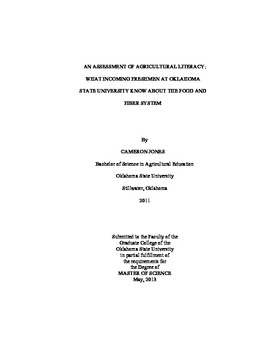| dc.description.abstract | Throughout the past three decades, numerous efforts have existed to increase the agricultural literacy of not only K-12 students, but also adult U.S. citizens. The purpose of this census study was to assess the agricultural literacy levels of incoming freshmen at Oklahoma State University in the Fall semester of 2012. Respondents completed a 25-item test, modified from the Food and Fiber Systems Literacy (FFSL) examination, and responded to demographic questions. Overall, students from the College of Agricultural Sciences and Natural Resources (CASNR) earned the highest scores followed by students in the College of Engineering, Architecture, and Technology (CEAT). Participants from the College of Arts and Sciences (A&S) had the lowest mean scores. Comparisons of agricultural literacy scores were made between males and females; home community sizes (i.e., city, suburb, town, and rural); agriculture courses taken at the high school level; participation in FFA and 4-H in high school; perceptions of previous agricultural knowledge; and between the five thematic themes of the FFSL Framework. Male students outscored female students. Students from a town outscored students from home community size of rural, suburb, or city. Those students who took agriculture courses in high school outscored those who did not. Likewise, students who were members of FFA or 4-H outscored those who were not. Students who perceived their previous knowledge of agriculture to be above average outscored those who indicated average, and students who perceived their previous agricultural knowledge as below average scored lowest. CEAT students outscored CASNR students in thematic area 1 - Understanding Agriculture, while CASNR outscored A&S, College of Education (COE), and College of Human Sciences (CHS) in thematic areas 2 - History, Geography, and Culture and thematic area 3 - Science, Technology, and Environment. No statistically significant differences were found between colleges in thematic area 4 - Business and Economics. Regarding thematic area 5 - Food, Nutrition, and Health, CASNR students outscored A&S and COE students. Given the low agricultural literacy scores of students in all colleges, it is recommended that Oklahoma State University offer a general education course for students over the food and fiber system. | |
